Matador Network's Blog, page 112
October 9, 2024
Matador Creators Spotlight: @ChewsToExplore on How to Build a Successful (and Profitable) YouTube Channel

Matador Creators is a place where people who love to travel can come together. It’s a community for talented travel writers, editors, photographers, filmmakers, and influencers. Whether you’re a seasoned pro or just starting, you can find support, inspiration, and opportunities to grow your career. From paid gigs to press trips and tips on tools that can help you in the industry, the platform is a place to connect with other travelers, share your experiences, and learn from others.
Here, we chat with creators Chew and Olivia of the Chews To Explore YouTube channel. The married duo discusses how they grew their channel from scratch and monetized from posting weekly videos.
This interview has been edited for clarity and length.
Matador: How did you start growing your YouTube channel?Initially, we created videos based on our experiences and what we found interesting. We didn’t have a specific strategy. However, after analyzing our analytics and identifying which types of videos performed well, we better understood what our audience found helpful and enjoyable.
Our audience was particularly interested in budget-friendly content that helped them plan their trips. By focusing on providing valuable information tailored to our viewers’ needs rather than centering content around ourselves, our channel started to grow.
Are you in the YouTube partner program?Yes, we are in the YouTube Partner Program. It took us about nine months of posting videos one to two times per week to get monetized. At the time, the requirements were 1,000 subscribers and 4,000 watch hours within the last 12 months. After meeting this criteria, it took us four more months to receive consistent payments from YouTube ads. In addition to ad revenue, we monetize by creating downloadable destination travel guides. These guides are designed to help our audience better navigate their trip planning and are linked in the descriptions of our related YouTube videos.
Do you get approached by travel brands for partnerships?

Yes, we have been fortunate to partner with several companies in the travel industry. Here are a few examples:
Tourism Board of Puerto Rico: For this DMO, we were invited to explore and create two reels showcasing the island’s southern region.
Priceline: We collaborated to create two reels promoting its “25 Days of Deals” to celebrate its 25th anniversary.
Safety Wing: For Safety Wing, we produced a reel highlighting the importance of travel medical insurance.
Viva V Samana by Wyndham: We created reels and a YouTube video sharing our experience staying at this all-inclusive resort.
These partnerships have allowed us to share valuable information and experiences with our audience while collaborating with reputable, budget-friendly travel industry brands that align with our “See the World, Save a Dollar” motto.
What are your best-performing videos, and have you noticed patterns?Our best-performing videos on YouTube are “Know Before You Go” videos for specific destinations and full recap videos that include detailed price breakdowns of every dollar spent on a trip. Both types of videos provide significant value to our audience by offering essential information and practical tips that make trip planning easier and more accessible. We’ve noticed that our viewers appreciate content that helps them prepare for their travels and manage their budgets effectively.
You also have a large presence on Instagram and TikTok. Are you in the creator program on either of those platforms? How does the YouTube creation process compare to TikTok and Instagram?Yes, we are in the Instagram and TikTok creator programs, but we focus most of our energy on YouTube. While short-form content on Instagram and TikTok is quicker to create, we love creating longer videos on YouTube, where we can really go into the details of our travel stories. Moving forward, we plan to be more intentional with our short-form videos to maintain viewer engagement and generate consistent income, similar to what we achieve on YouTube.
Do you have any tips for up-and-coming travel creators?Consistency is key. Don’t start with the sole intention of making money. While there are opportunities to earn, it requires a lot of hard work and dedication. If your main goal isn’t to provide value and help your audience, you might burn out from the effort with little immediate reward. Some creators gain popularity quickly, while others take longer; everyone has their own journey. Make sure you genuinely enjoy creating content and sharing your experiences. Focus on what you love, and the rewards will follow in time.
What are your next goals on social media?Our goal is to reach 100,000 subscribers on YouTube by the end of the year. We want to help as many people as possible: “See the World, Save a Dollar.” In other words, how to have high-value experiences around the world for less cost. 
I Went to Scotland to See Where ‘Outlander’ Was Filmed. Fans, These Are The Sites You Need to See.
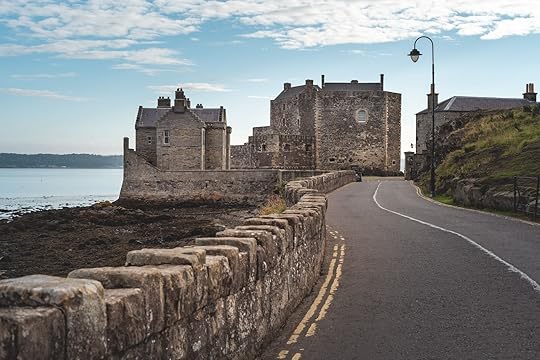
I’m a devout fan of the Outlander books, so much so that I once spent a week making an 18th-century corset inspired by the main character, Claire. That’s why, when presented with an opportunity to visit Scotland and tour various filming locations for the long-running TV adaptation, I jumped at the chance.
Based on the books by Diana Gabalon, Outlander is one of the most successful recent TV shows filmed in Scotland, joining the ranks of popular movies and series like Skyfall, Harry Potter, Monty Python, and The Buccaneers. Captivating audiences and travelers alike, the genre-bending story blends history, science fiction, and romance against the backdrop of the 18th-century Jacobite Rebellion against England. As the story has played out on screen, the show has kept fans swooning over the Scottish countryside, the castles, and, let’s be honest, the muscular kilted hero, Jamie Fraser.
Over a whisky-pairing dinner at Mharsanta in Glasgow, I chatted with musician and Gaelic language activist Àdhamh (pronounced Argiv) Ó Broin who taught the Outlander cast how to speak the original Scottish language.
“Actually, Sam Heughan, who plays Jamie, was pretty decent,” he told me. “I taught six of the cast: three were brilliant and three had cloth ears.” (Ó Broin declined to divulge the names of the “cloth-eared” cast members but hinted that he encouraged screenwriters to give actor Grant O’Rourke, who played Rupert, more lines and Duncan LaCroic, who played Murtagh, fewer).
Ó Broin is passionate about his efforts to increase Gaelic’s popularity and will only speak the Celtic language to his children — and for good reason. Of the roughly 5.5 million people who currently live in Scotland, only about 60,000 speak Gaelic, he explained. “But there are 100,000 people trying to learn on Duolingo.”
I wonder if they’re all Outlander fans.
It’s a fair question. Since 2013 when the TV show began, Outlander has been a significant driver for Scottish tourism, a phenomenon known as the Outlander Effect. As fans wait for the last season of the series to premiere and more books to be released, a set-jetting trip to Scotland is sure to scratch the Outlander itch. These are the filming locations I visited (and you should, too).
First thing’s first: How are Outlander filming locations in Scotland chosen?
Photo: Kerstin Rodgers
Location scouts have a lot to consider when picking places to shoot. For one thing, filming is an expensive business. The production team needs infrastructure nearby, as well as locations that can be aged. Crew members must remove telegraph poles, satellite dishes, and any modern street furniture such as electric wiring. Then, there’s the matter of filming inside a historic location, which I learned about from the historian and guide of the Newhailes House (more on that below).
At historic properties, all of the original furniture, paintings, and decorative objects must be removed and carefully stored, although sometimes a production team will book the use of certain decorations or furnishings. Any modern lighting, such as electric lights and switches at the location, must be removed or covered. Floors must be protected: Filming equipment is heavy, especially any tracks along which cameras move, and that can damage historic floors. Film and TV lighting is powerful and hot, so crew must be careful that it doesn’t burn ancient wall coverings and paintwork.
At Newhailes House, the Outlander production team booked three months for only one actual day’s worth of filming.
Outlander filming locations in Scotland, organized by categoryCastles and forts: exteriorsDoune Castle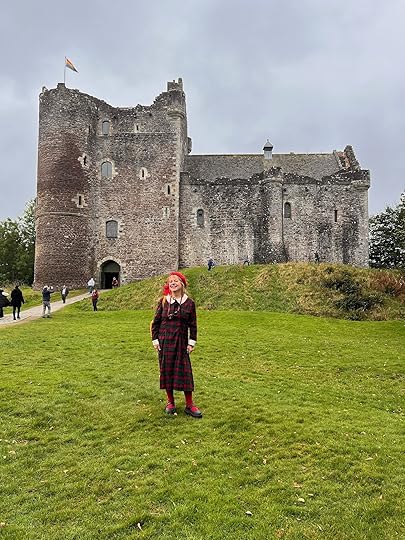
Photo: Kerstin Rodgers
In central Scotland, I visited the 14th-century Doune Castle, which serves as the fictional Castle Leoch in Outlander, as well as Winterfell in the pilot for Game of Thrones. I recognized the exterior and courtyard from the beginning of the first season when Claire first arrived in 18th-century Scotland (although the courtyard was transformed for TV with rustic wooden structures and hay strewn on the floor).
As TV crews have to be extremely careful with historic buildings to make sure that nothing is damaged, the interior scenes of Castle Leoch were recreated on a set. That didn’t detract from seeing Doune Castle’s real interior, however. Highlights included the kitchen with its cavernous fireplace, the wall marked by slashes where knives were sharpened, and the giant stone serving hatches where food rested before being delivered to the lord and lady at their feasting table.
A guide told me that author Diana Gabalon herself has been seen wandering the castle, gathering inspiration, and Sam Heughan himself recorded the audio guide.
Doune Castle: Castle Hill, Doune FK16 6EA, UK
Midhope Castle
Photo: Kerstin Rodgers
About 30 minutes outside of Edinburgh, the ruins of Midhope Castle on the Hopetoun House grounds were used as the exterior setting for Jamie’s ancestral home, Lallybroch. Our guide, the kilted James from Rabbie’s Tours, told us that the production team covered the windows of the ruins, presently just empty gaps, with mock 18th-century glass windows.
Fun fact: According to some French fans I met who while visiting Midhope Castle, Outlander is dubbed into French using French actors, but when Jamie speaks Gaelic, it reverts to Sam Heughan’s original voice.
Midhope Castle: Midhope, Abercorn, South Queensferry EH30 9SL, UK
Blackness Castle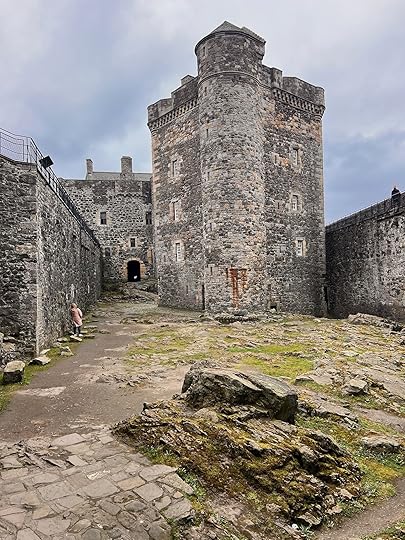
Photo: Kerstin Rodgers
Blackness Castle, a short drive from Midhope Castle, is a 15th-century fortress perched near a misty shore on the Firth of Forth (“ness” translates to water). The atmospheric building appeared in Outlander on multiple occasions: It’s where Jamie had to rescue Claire when she was captured by the evil English soldier Jack Randall, as well as the location of the prison where Jamie was tortured by “Black Jack” Randall (some of the other prison scenes were filmed at nearby Linlithgow Palace).
Shaped like a stone ship, Blackness Castle features multiple spiral stone staircases leading to ramparts with tempestuous waters splashing over black rocks. The bleak location also doubled as Hamlet’s castle in the film by Franco Zeffirelli.
Blackness Castle: Blackness, Linlithgow EH49 7NH, UK
Dean Castle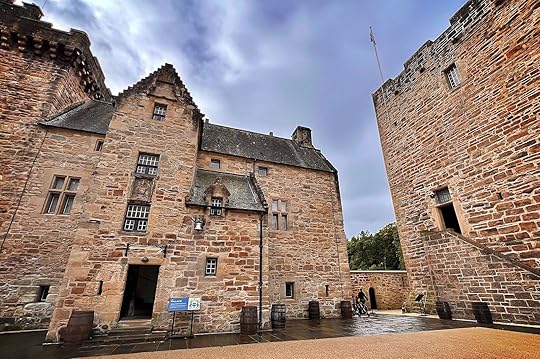
Photo: Kerstin Rodgers
South of Glasgow in Kilmarnock, I visited Dean Castle, which stood in for Beaufort Castle in the eighth episode of Outlander’s second season when Claire asked Lord Lovat, Jamie’s grandfather, for help. The castle’s courtyard, again aged to resemble the 18th century, appeared in several scenes.
Dean Castle: Dean Rd, Kilmarnock KA3 1XB, UK
Castles and forts: interiorsNewhailes Mansion House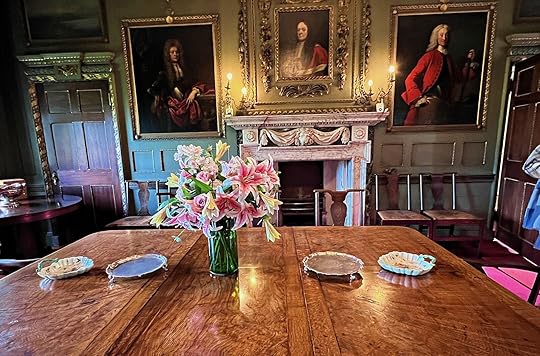
Photo: Kerstin Rodgers
At the 17th-century Newhailes Mansion House, east of Edinburgh, a National Trust of Scotland historian named Diane guided my group. She recounted a chilling moment when she was alone in the building and heard her name being called.
“I know there are presences, what they call residual activity, but I didn’t like that they used my name” she said. “It felt too personal, so I spoke aloud asking them not to do that.” As I listened to Diane’s story, I glanced around and felt a shiver down my spine.
One memorable stop on the tour was the dimly lit dining room, which featured paintings on either side of an Italian marble fireplace. A paint analysis of the room showed that it had only ever been painted twice, both times a rare and olive green made from dyes derived from plants such as hawthorn trees, so the current color is historically accurate. Scenes from Outlander were filmed in both the living and dining rooms, and the prop department was asked to keep the original paintings on the wall. In season four of the show, fans may remember fake candles lighting the mansion while the pre-revolutionary British Governor Tryon Claire entertains Claire.
Fun fact: In true rococo style, stucco embellishments and gilded scallop shells surround the mansion’s paintings. The scallop shell was a symbol of the Jacobins, supporters of the Catholic Stuart line, in the 18th century. You’ll also see the shell on the Santiago de Compostela pilgrimage in Spain (Saint Iago means James), and in French, scallops are known as coquilles de Saint Jacques.
Newhailes Mansion House: Newhailes, Musselburgh EH21 6RY, UK
Traquair House
Photo: Duncan2406/Shutterstock
Although the origins of Traquair House, Scotland’s oldest inhabited castle, aligns with Outlander’s era, it wasn’t actually used in the show, much to the disappointment of current owner Catherine Maxwell Stuart, the first female laird (estate owner). Filming attracts visitors, which brings income to costly castles. However, I suspect that Diana Gabaldon drew inspiration from the history of the house and its inhabitants. In the castle’s ancient library, visitors can see coded letters on display that were sent between Jacobite agents, a storyline that’s featured in the Outlander books.
The family that inhabits Traquair House are recusant Catholics, meaning they refused to attend Church of England services post-Reformation, a crime punishable by death, fines, and prison until the 1920s. They were an original part of the Jacobite movement, and their constant danger of arrest in Protestant Britain in the past explains the castle’s secret stairwells and priest’s holes.
One of Stuart’s predecessors, Lady Winifred Maxwell, whose oil portrait peers down at visitors in the living room, daringly rescued her husband from the Tower of London prison. After petitioning King George I for clemency but failing to free her husband, Lady Winifred visited the tower hiding an extra cloak and petticoat. Her husband escaped, dressed as a servant with his face patted with makeup, while Winifred remained in his cell and pretended to converse, even imitating his voice. This is reminiscent of the heroic lengths that Claire goes to save Jamie.
Despite not serving as a filming location, Traquair House’s history makes it a fascinating addition to any Outlander itinerary. Much as Mary Queen of Scots once stayed there — you can see her handbag, purse, shoes, and the bedroom she slept in — three of the castle’s rooms are bookable on Airbnb for $315 per night.
Traquair House: Traquair House, Traquair, Innerleithen EH44 6PW, UK
Historic villages and townsCulross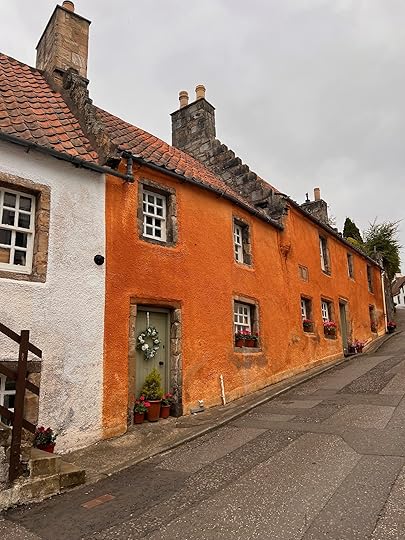
Photo: Kerstin Rodgers
Culross is a village in Fife, roughly located between Glasgow and Edinburgh. A well-preserved example of a 17th-century Scottish burgh, Culross posed as Cranesmuir in Outlander where the witch Geilis Duncan, along with Claire, was put on trial for witchcraft. You can see her towering house complete with one of the village’s characteristic owl holes, or places for owls to perch and hunt vermin in attics. (This custom also served as inspiration for JK Rowling and her Harry Potter series.) While in Culross, be sure to stop by the village green, as well. There, a boy had his ear pinned to a wooden post as a punishment for theft, inspiring the phrase “tearaway.”
Falkland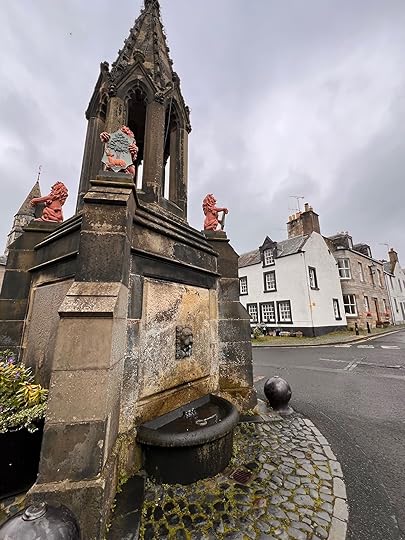
Photo: Kerstin Rodgers
Another town in Fife that’s worth a visit for Outlander fans is Falkland, which represented Inverness in the show where Frank and Claire stayed at Mrs. Baird’s bed and breakfast. In Falkland, I stood next to the Bruce Fountain where Jamie’s ghost was spotted looking up at Claire’s bedroom, making for a great photo opp. History buffs might also enjoy Falkland Palace, once a royal residence for the Stewart monarchs.
Troon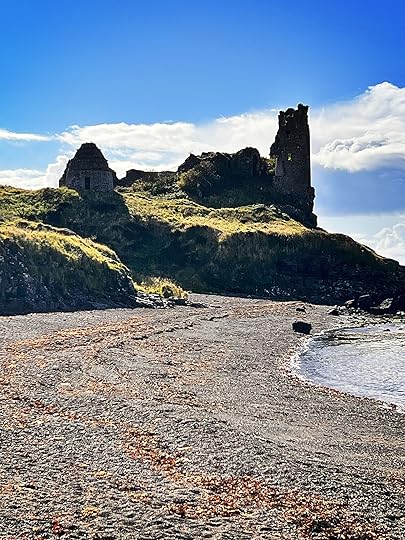
Photo: Kerstin Rodgers
Troon is a charming coastal village and port in South Ayrshire on southern Scotland’s west coast that overlooks the island of Arran. In Outlander, it was transformed into the port where Jamie and Claire set off by tall ship to America.
Bonus: Outlander filming locations in Scotland used for American scenes
Photo: EvaGZ/Shutterstock
Interestingly, Outlander scenes set in North Carolina were actually filmed in Scotland, as well. Parts of North Carolina resemble Scotland, which is one reason why many Scots were attracted to it after the Battle of Culloden in the mid-18th century. In fact, James, my group’s Rabbies guide, told us that Indigenous phrases such as Mohican (meaning “my hair”) and moccasin (meaning “my shoe”) derived from Gaelic.
The Arniston House in Midlothian and Beecraigs Country Park in Linlithgow are among the Outlander scenes filmed in Scotland that represent North Carolina in the show. 
A New High-Speed Train Links Paris to Berlin in Time for Christmas Market Season

Surprisingly, among the vast rail network that covers Europe, there is currently no direct day train service between two of the continent’s most visited cities: Paris and Berlin. It’s all about to change starting in December 2024, however. Thanks to an agreement between the SCNF and DB, the national railway companies of France and Germany, a new direct, high-speed train service will connect both capitals in just eight hours.
The new rail service will be operated by German ICE trains (the fastest trains in Europe) and will run once per day, leaving Paris Gare de l’Est at 9:55 AM and arrive in Berlin Hauptbahnhof at 6:03 PM. The return route will leave Berlin Hauptbahnhof at 11:54 AM and arrive in Paris at 7:55 PM. There will be only three stops along the way: one in Strasbourg, France, one in Karlsruhe, Germany, and one in Frankfurt, Germany.
The route will launch on December 16, 2024, right on time for travelers to make their way to Berlin and see the German Capital’s many Christmas markets, including the one on Breitscheidplatz where revelers can enjoy mulled wine, gingerbread, and handcrafted toys from over 100 stalls, as well as carrousel rides.
A direct rail link between Paris and Berlin will not only satisfy travelers’ increasing interest in train travel, but it will also likely encourage everyone to opt for a mode of transport that is more sustainable than flying. According to the SCNF, traveling by train between the two European capitals will emit 100 times less CO2 than flying the same route, more precisely 2Kg instead of 200Kg of CO2.
Currently, traveling by train between Paris and Berlin requires at least one connection, but often necessitates more, and involves multiple stops, making the journey lengthy.
Take it from someone who’s experienced that route recently. I traveled between the two cities in July by way of one Eurostar and one ICE train, and had to connect in the extremely busy and crowded main train station in Cologne for over one hour. A direct ride would have been a lot more comfortable and practical on my very long train journey to reach the German island of Rügen.
Nightjet, operated by ÖBB, the national railway company of Austria, is currently the only one offering a direct rail link between Paris and Berlin, and only does so in sleeper trains that run overnight. The night ride take a little over 14 hours and starts at $38 (€34.90) for a seat in a six-person carriage and $98 (€180) for a private compartment with several berths.
Reservation for the new direct, high-speed train service between Paris and Berlin start at $65 (59.99 €) and will open on 16 October. 
For Sophisticated Charm in Grindelwald, Visit the Boutique Hotel Glacier

Grindelwald, the iconic mountain town a train’s ride from Interlaken in south-central Switzerland, is renowned for its breathtaking alpine views of the Eiger and other prominent peaks. The Boutique Hotel Glacier perfectly captures that beauty from your room. The entire south side of the hotel is designed to showcase the . From the bottom-floor spa to the ground-floor restaurant, floor-to-ceiling glass walls frame the scenery, while the rooms feature glass doors that span nearly the entire wall for an uninterrupted view. While the hotel blends into the traditional alpine chalets surrounding it, its elegant, modern updates give it a unique charm. Dating back to 1864, Hotel Glacier effortlessly marries history with contemporary luxury, nestled beautifully against the mountain and local farmhouses.
We hope you love the Boutique Hotel Grindelwald! Just so you know, Matador may collect a small commission from the links on this page if you decide to book a stay. Listed prices are accurate as of the time of publication.
Rooms at Boutique Hotel Glacier
@epic.stays Wake up to breathtaking mountain views atHotel Glacier in #Grindelwald

@Joanna | Travel Creator #switzerlandtravel #luxuryhotel #switzerland #creatorsearchinsights ♬ Good Days – Yenibi
The original hotel and restaurant has undergone several upgrades and expansions and is now a 4-star boutique hotel with 28 rooms. The rooms on the north side face Reeti Mountain and Schwarzhorn Mountain, while the south-facing rooms offer direct views of Eiger Mountain. All of these south-facing rooms come with private balconies perfect for enjoying the stunning scenery with your morning coffee. Of the south facing rooms there are five “Signature Rooms” that feature a private whirlpool. I stayed in one of these Signature Rooms, and it was the epitome of peaceful seclusion. We enjoyed our coffee on the balcony in the crisp morning air and sipped wine in the whirlpool by night, winding down after long days of hiking.
Each Signature Room features a luxurious king-size bed with a COCOMAT mattress, along with a comfy seating area and a large bathroom. The rooms are also outfitted with modern conveniences, including a TV with Apple TV, a Nespresso coffee machine, a Marshall Bluetooth speaker, and complimentary high-speed Wi-Fi. But the best part – and where you’ll spend most of your time – is out on the balcony enjoying the hot tub and mountain views.
Amenities at Boutique Hotel Glacier Photo courtesy Boutique Hotel Glacier
Photo courtesy Boutique Hotel Glacier Photo courtesy Boutique Hotel Glacier
Photo courtesy Boutique Hotel GlacierThe hotel takes priority in your wellness. To match the whirlpools in some of the rooms they also feature a wonderful spa and gym. The spa has a traditional steam sauna as well as a hammam, both perfect for relaxing your muscles after a long day. In the traditional sauna they even leave the bucket and ladle to decide how intense you want the experience to be. Additionally, you can indulge in a massage for an extra fee. The spa also boasts a number of water beds, an open-air whirlpool, and a relaxation area with refreshments—all offering breathtaking views of the Eiger mountain.
Things to do in Grindelwald
Photo courtesy Boutique Hotel Glacier
While in town we took advantage of the local attractions. With our stay we received passes to the local bus to get around. The area is unique for its abundance of beautiful hikes throughout the Jungfrau region, as well as various adventure attractions. The most popular attraction in the area is Grindelwald First. The gondola to First starts from the middle of town and takes you up 25 minutes to 2,168 meters (7,113 feet) above sea level. From here we walked the Cliff Walk trail, which wraps around the peak and across a suspension bridge to a view of the high alpine. From here you have the options of ziplining or taking a four-person glider, both of which will fly you down the mountainside at about 50 mph.
After this, instead of taking the gondola all the way back down, you can choose between a 3-wheel mountain cart or a standing trottibike scooter. Either will take you down the mountain past the flower meadows, grazing cows, and farm houses. There are tons of breathtaking hikes and gorge walks for all levels in the Jungfrau region.
Restaurants at the Boutique Hotel Glacier
@epic.stays Breakfast with a view that’s almost too beautiful to be real
Hotel Glacier in #Grindelwald

@Joanna | Travel Creator #switzerlandtravel #luxuryhotel #switzerland ♬ beautiful things dont ask for attention – mathias i think
Glacier has been a hotel and restaurant from the start, and the staff take just as much pride in their dining experience as they do in their wonderful accommodation. Restaurant Glacier is a fine dining fusion of traditional Alpine with a French Finesse. The menu features both 5- and 7-course tasting options that showcase the vibrant flavors of the mountains. Additionally, the hotel offers the à la carte restaurant, Petit Glacier. No corners were cut in the hotel, even the complimentary breakfast buffet was spectacular. It went beyond the standard bacon and eggs, providing an array of meats, cheeses, spreads, breads, and coffee. The nicest touch was the option of champagne on the terrace.
How to get hereThere are two main ways to get to Hotel Glacier. We rented a car and drove from Geneva which was about a 2.5-hour drive. Gridelwald is a small alpine town making it very easy to navigate through. There is parking on site and with everything being so close there wasn’t much need for the car after arriving. The second and seemingly more popular option was to take the Swiss Railways using the Swiss Travel Pass. You can catch a train from most cities in Switzerland including Geneva and Zurich. 
October 8, 2024
Matador Creators Tool Spotlight: AsqMe on How to Monetize From Viewer Questions

The Matador Creators team wants to set travel creators up for success. Whether you end up booking a gig through Matador, we want to share resources that can guide your creation process long-term and help you find new ways to monetize your content.
Here we talk with AsqMe’s co-founder, James Alexander. AsqMe is a platform that allows creators to monetize directly from questions their audience asks. Fans and followers can “skip the line” in YouTube, Instagram, or TikTok comments to guarantee a response via AsqMe. With travel creators, this could relate to an upcoming trip itinerary, travel suggestions and tips, and anything else related to your content.
This interview has been edited for clarity and length.
Matador: What are the main benefits of AsqMe?James Alexander: Creators benefit from using AsqMe by having a single inbox to manage questions from across all of their platforms, which helps them stay organized and save time. AsqMe also enables users to generate additional revenue by answering questions from their audience and provides tools like AI-powered FirstDraft to help craft and expedite responses efficiently. Creators have the flexibility to set the price for their expertise or charge nothing at all, allowing them to monetize their content in a new way while engaging with their audience and driving more views.
How do creators monetize, and how much can they earn?Creators on AsqMe can monetize content by charging for answers or earning tips. The amount charged per answer is at the their discretion, with most charging between $10 and $20 per answer. On the Starter Plan, they keep 80 percent of their earnings. On the Pro Plan subscription, 100 percent. AsqMe has paid thousands of dollars to users, with active creators earning hundreds or more monthly. You can withdraw funds anytime from the AsqMe payment account, powered by Stripe.
Who can benefit from the platform?AsqMe is designed to be a versatile platform that can be used across various social media platforms to manage and monetize audience questions. Today, questions are coming through AsqMe to creators on YouTube, Instagram, TikTok, Patreon, Facebook, Linktree, and several other social media platforms, consolidating messages into a single inbox. Whether users charge for answers or not, they can use AsqMe as a powerful tool to manage audience engagement and streamline responses.
What can AsqMe do specifically for travel creators?AsqMe is a game-changing addition to the “creator stack” for those in the travel media industry. First, you can manage the influx of questions you receive by using AsqMe as a single inbox for all platforms, making it easier to engage with an audience and meet them where they are. As many travel creators have viewers from various countries who speak different languages, AsqMe’s auto-translate feature is especially useful.
Also, as those working in travel are experts whose content often generates serious questions requiring in-depth, detailed answers, AsqMe can easily offer “micro travel consulting” by enabling them to charge for these kinds of high-value answers.
Additionally, the platform allows users to answer questions with video responses, which can be particularly useful for those who wish to share visual content or detailed explanations.
And with FirstDraft, you can use your video content from YouTube as a private AI assistant to automatically craft rich, in-depth answers in seconds. FirstDraft will even find an appropriate video clip from the your archive and cue it up to just the right spot. It’s almost as if AsqMe were specifically designed for travel creators.
Are there any exciting updates coming up?How many of you re-watch your travel videos to answer viewer questions? How many are frustrated that many questions you get were answered in your videos, but the viewer didn’t watch long enough?
We are thrilled to be launching FirstDraft, the very first private AI assistant specifically designed for creators that writes answers to audience questions based on a creator’s video content. Here’s a one-minute video from one of our creator ambassadors talking about the new FirstDraft feature:
To get started all you need to do is connect your YouTube channel to your AsqMe account. Once connected, FirstDraft doesn’t just watch the videos, it understands them. When questions arrive, FirstDraft crafts answers that sound just like you. And each response comes with a video clip cued up to just the right spot, driving more video views. If an expert answer cannot be drafted from your content, a general answer is provided from ChatGPT.
AsqMe’s FirstDraft is unique because it is not an autonomous “bot.” You always get to review and edit the answers and video clips before sending them. We also never commingle creator data or share it with third parties like ChatGPT. FirstDraft is an assistant and will give back hours every week so you can make even more amazing content (or just take a nap).
How can creators sign up?It’s easy and free to sign up for AsqMe. Just visit AsqMe and tap “Sign Up” at the top. Creating an account takes less than four minutes. The two most important parts of the sign-up process are: 1. Connecting your YouTube account to AsqMe to take advantage of FirstDraft, and 2. Sharing your AsqMe link everywhere you post content. Creators who are most successful with AsqMe direct their audiences to ask questions through AsqMe in every video. 
Matador Creators Tool Spotlight: AsqMe on How to Monetize From Audience Engagement or Viewer Questions

The Matador Creators team wants to set travel creators up for success. Whether you end up booking a gig through Matador, we want to share resources that can guide your creation process long-term and help you find new ways to monetize your content.
Here we talk with AsqMe’s co-founder, James Alexander. AsqMe is a platform that allows creators to monetize directly from questions their audience asks. Fans and followers can “skip the line” in YouTube, Instagram, or TikTok comments to guarantee a response via AsqMe. With travel creators, this could relate to an upcoming trip itinerary, travel suggestions and tips, and anything else related to your content.
This interview has been edited for clarity and length.
Matador: What are the main benefits of AsqMe?James Alexander: Creators benefit from using AsqMe by having a single inbox to manage questions from across all of their platforms, which helps them stay organized and save time. AsqMe also enables users to generate additional revenue by answering questions from their audience and provides tools like AI-powered FirstDraft to help craft and expedite responses efficiently. Creators have the flexibility to set the price for their expertise or charge nothing at all, allowing them to monetize their content in a new way while engaging with their audience and driving more views.
How do creators monetize, and how much can they earn?Creators on AsqMe can monetize content by charging for answers or earning tips. The amount charged per answer is at the their discretion, with most charging between $10 and $20 per answer. On the Starter Plan, they keep 80 percent of their earnings. On the Pro Plan subscription, 100 percent. AsqMe has paid thousands of dollars to users, with active creators earning hundreds or more monthly. You can withdraw funds anytime from the AsqMe payment account, powered by Stripe.
Who can benefit from the platform?AsqMe is designed to be a versatile platform that can be used across various social media platforms to manage and monetize audience questions. Today, questions are coming through AsqMe to creators on YouTube, Instagram, TikTok, Patreon, Facebook, Linktree, and several other social media platforms, consolidating messages into a single inbox. Whether users charge for answers or not, they can use AsqMe as a powerful tool to manage audience engagement and streamline responses.
What can AsqMe do specifically for travel creators?AsqMe is a game-changing addition to the “creator stack” for those in the travel media industry. First, you can manage the influx of questions you receive by using AsqMe as a single inbox for all platforms, making it easier to engage with an audience and meet them where they are. As many travel creators have viewers from various countries who speak different languages, AsqMe’s auto-translate feature is especially useful.
Also, as those working in travel are experts whose content often generates serious questions requiring in-depth, detailed answers, AsqMe can easily offer “micro travel consulting” by enabling them to charge for these kinds of high-value answers.
Additionally, the platform allows users to answer questions with video responses, which can be particularly useful for those who wish to share visual content or detailed explanations.
And with FirstDraft, you can use your video content from YouTube as a private AI assistant to automatically craft rich, in-depth answers in seconds. FirstDraft will even find an appropriate video clip from the your archive and cue it up to just the right spot. It’s almost as if AsqMe were specifically designed for travel creators.
Are there any exciting updates coming up?How many of you re-watch your travel videos to answer viewer questions? How many are frustrated that many questions you get were answered in your videos, but the viewer didn’t watch long enough?
We are thrilled to be launching FirstDraft, the very first private AI assistant specifically designed for creators that writes answers to audience questions based on a creator’s video content. Here’s a one-minute video from one of our creator ambassadors talking about the new FirstDraft feature:
To get started all you need to do is connect your YouTube channel to your AsqMe account. Once connected, FirstDraft doesn’t just watch the videos, it understands them. When questions arrive, FirstDraft crafts answers that sound just like you. And each response comes with a video clip cued up to just the right spot, driving more video views. If an expert answer cannot be drafted from your content, a general answer is provided from ChatGPT.
AsqMe’s FirstDraft is unique because it is not an autonomous “bot.” You always get to review and edit the answers and video clips before sending them. We also never commingle creator data or share it with third parties like ChatGPT. FirstDraft is an assistant and will give back hours every week so you can make even more amazing content (or just take a nap).
How can creators sign up?It’s easy and free to sign up for AsqMe. Just visit AsqMe and tap “Sign Up” at the top. Creating an account takes less than four minutes. The two most important parts of the sign-up process are: 1. Connecting your YouTube account to AsqMe to take advantage of FirstDraft, and 2. Sharing your AsqMe link everywhere you post content. Creators who are most successful with AsqMe direct their audiences to ask questions through AsqMe in every video. 
How Cache_Seven Connects Adventurers to Local Guides Who Know the Outdoors Best

The Matador Creators team wants to set travel creators up for success. Whether you end up booking a gig through Matador or the opportunities we provide lead to work elsewhere, we’re always looking to highlight resources that can guide your creation process long-term and help you find new ways to monetize the work you do.
Cache_Seven is a new company that makes connects the people who know the outdoors best — local guides — with people who want the inside scoop on where to go, what to do, and what gear to use. Think of the people on Cache_Seven like the friend who always has the best intel. The collective of guides and outdoor enthusiasts are experts in a wide range of activities (and the gear it takes to do things properly) across the United States and Europe: sailing, fishing, surfing, kitesurfing, kayaking, climbing, hiking, and mountain biking, to start.
While the company launched only a few months ago, it already features hundreds of guides who are ready to share their experience. For travelers, it’s a great resource to find guides you can trust. For guides, it’s a way to monetize their passion through tours and affiliate gear commissions.
We caught up with Cache_Seven’s founder, Kevin Luzak, to learn more about how his company brings outdoor professionals and adventurers together.
This interview has been edited for length and clarity.
View this post on InstagramMatador: How does Cache_Seven serve adventurers vs. professionals?A post shared by Cache_Seven (@cache_seven)
Kevin Luzak: Cache_Seven is a platform that brings outdoor pros together with adventurers of all experience levels across eight different activities, including hiking, cycling, and rafting. We help adventurers take the first step in planning an excursion, and we make this step as efficient as possible by introducing them to industry professionals with deep expertise and knowledge in their areas of interest. We help those pros build out Cache_Seven websites that showcase their backgrounds and interests in an effort to help expand their client base. The sites also present a list of the gear that the pros recommend for their clients. We have an affiliate marketing network of thousands of brands. If visitors make purchases off a gear list, then the pro receives a cut of the transaction.
Are certain credentials needed for someone to sign up as a professional?We do not require credentials, but we encourage pros to include detailed descriptions of their experience and expertise on their Cache_Seven sites.
How are you building up both userbases?We have been building up pro participation through direct outreach, social media, and, to a lesser extent, through sponsoring events where they congregate. At this point, we have onboarded more than 250 individuals since we launched in early June. With this group on the platform, we believe we are gaining a critical mass, and have recently begun marketing to adventurers. We are reaching them through social media and event sponsorships.
Cache_Seven caters to a bunch of outdoor activities. What’s most popular on the platform? Are there plans to add any others?The most popular vertical on the platform right now is fly fishing. We attribute at least part of this skew to the fact that we launched during fishing season in two markets — Jackson, Wyoming, and Sun Valley, Idaho — where this sport is huge during the summer. We have also gained significant traction in cycling as well as some of our ocean activities like kiting and sailing. We are open to adding activities down the road, but we feel like we have our hands full at the moment.
Based on a look at the interactive map, it looks like North America and Europe are the current regional focuses. Is the plan to extend to other places around the globe?We hope to become a truly global platform over time and feel that there is a tremendous demand for access to foreign pros. Adventurers tend to have an idea about how to coordinate local trips, but often have no idea where to start when the trip involves different countries. This buildout can be done organically to a large extent — US pros often spend time guiding in other countries, which gives us a foot in the door. Our current European relationships have generally developed along these lines. We also intend to build direct relationships with non-US guides once we get the US business off the ground.
Anything else you want to share with Matador readers?We are very focused on community — the community of pros and adventurers is our primary focus as a platform — but we are also involved with the physical communities in which the activities that we are trying to promote take place and the communities of people who are dedicated to the activities that we focus on. We want to use the Cache_Seven platform as a way to highlight organizations within these latter two communities that make them better, so we have added a ninth spot in our matrix that is dedicated to philanthropies. We help them set up Cache_Seven sites and use these sites to describe what they’re doing and to drive visitors to their websites (and ideally convert them to donors). For those organizations that are associated with activities, we help build gear lists and direct 100 percent of any affiliate fees to them. 
Controversy Defines the Movement to Protect Dolores River Canyon. That’s Why It Will Be Successful

I first saw a “Protect The Dolores” sign in a neighbor’s yard in 2023. Before that, I’d heard rumor that a movement to establish the Dolores Canyons National Monument around the Dolores River in Colorado’s Mesa and Montrose counties was taking hold. I’m typically an adamant supporter of conservation efforts like this, but opponents to the national monument plan included many people I know who live near or in Colorado’s Grand Valley, which is the largest population center near the proposed monument. I hesitated to voice support because some of these concerns spoke to me as a local resident: Do we want more people coming through? Will federal management result in tighter restrictions on access to outdoor recreation?
I’ve since come around to support the designation efforts. The movement to protect the area has laid bare how it will or won’t impact the things that matter to the outdoor community. Intense scrutiny and controversy, in fact, is ultimately why it will be successful.
What’s the case against the Dolores Canyons National Monument?
Photo: Sergey Malomuzh /Shutterstock
The proposed Dolores Canyons National Monument would protect approximately 400,000 acres of public lands in western Colorado, primarily in Mesa County with some land in Montrose County. This vast area encompasses a diverse range of public land featuring canyons, rivers, forests, and high-altitude meadows that have historically been largely left alone as is. The exception has historically been for uranium and vanadium mining. The national monument designation would allow for a wide range of recreational activities, such as hiking, camping, fishing, hunting, wildlife viewing, photography, and rock climbing – and would limit future mining permits and extractive development.
Hence the crux of the issue for some local residents. Western Colorado has a rich history of oil and gas development and mining. The proposed national monument site is part of the Uravan Mineral Belt, which was the biggest source of uranium, vanadium, and radium in the country from the end of World War II through the 1970s. Although periods of boom and bust still happen, these industries have been in decline in the region since the 1980s. Long-time residents, particularly those who have worked in the mines or who have family members who did, are hesitant to see hundreds of thousands of acres cut off from future mining development, just as the country works towards a massive decarbonization effort that will require ample mining to produce batteries and other technologies.
Public comment periods, statements from county commissioners, and op-eds in local publications have highlighted other concerns about the monument designation. For on, there’s access to public lands for hunters and anglers, though advocates for the monument have said these groups will see minimal impact. Some are concerned about grazing and property rights, and others simply don’t trust the federal government to manage land that in their view has done just fine without broader intervention. Mesa County Commissioners released a draft plan far smaller than what is proposed to become a national monument, seeking to protect that smaller area instead as a National Conservation Area. This would allow easier access for extractive industries to gain permits to the area, while also allowing for extensive recreation opportunities and leaving the bulk of the proposed 400,000-acre monument unaffected.
What’s the case for the Dolores Canyons National Monument?
Photo: Linda Armstrong/Shutterstock
At its core, the case for the Dolores Canyons National Monument centers on pillars commonly used in conservation circles. First, there’s all the land that would be protected from development and from extractive industries. This preserves extensive wildlife habitat and a river system that has been increasingly strained by climate change. The Dolores River is beloved by river runners, but flows only reach raftable levels about once every four or five years, on average. Tying these things together is the Road to 30 initiative to conserve 30 percent of the country’s land by 2030, which advocates believe is crucial for protecting wildlife habitat and reigning in unnecessary development.
From an economic standpoint, creating a national monument would increase tourism to the region and create jobs that aren’t dependent on the swings of oil and gas development or mining. This is happening across the Western United States as towns, states, and regions seek to stabilize their job markets and economies for the future.
Protect The Dolores, the advocacy group supporting the monument designation, says on its website, “A national monument designation would ensure that these public lands are managed in a manner that prioritizes the conservation of biodiversity, creates opportunities for local input, balances the needs of protecting nature and sustaining local economies, and preserves public access for recreation and traditional uses like hunting and grazing.”

Map of the proposed monument. Courtesy Protect The Dolores
Colorado’s two senators, John Hickenlooper and Michael Bennet – both Democrats – have each visited the region to hold town halls on the monument. As of this writing, neither has stated whether they will vote for or against the monument. I suspect they will come out in favor, not simply based on party affiliation, but because the base of the anti-monument movement is so localized to a small area called West End, and primarily to one political side within that area. The West End is a largely conservative, agricultural region near the Utah border that until recently had missed out on the economic boom Colorado has seen from population and tourism growth over the past 30 years. This began to change following the 2020 opening of Camp V, a Burning Man-esque glamping resort, and a spate of new trail development for bikers and hikers near Norwood, Nucla, and Naturita. A marketing campaign focused on outdoor recreation in West End now highlight the draws of this more remote edge of Colorado
It’s critically important to consider the opinions of all residents in making decisions that affect the regions where they live. However, with this comes the need to decipher when these opinions stem largely from a fear of change, or a desire to preserve industry that is no longer relevant to the region’s long-term future. Outdoor recreation directly employs more than 130,000 Coloradans, and tens of thousands more (including this writer) indirectly. The great outdoors is what draws people to the state, and this will play a much larger role in Colorado’s future than oil and gas development or mining.
As a resident of western Colorado and someone who has lived in the state all my life, I waffled on support for the monument, despite being someone who largely supports conservation movements and regularly donates to environmental organizations. That’s because of the concerns expressed by opponents regarding the “selling out” of the area that could happen following a national monument designation. Infrastructure for mass tourism is absent in the West End. Many new residents are simply tourism industry workers priced out of nearby Telluride. One question is unavoidable in any conversation about the national monument designation: The river canyon has existed for millions of years as it is – does it really need the federal government to come in and assert control?
Why the movement to protect Dolores Canyons National Monument will succeed
Photo: Sergey Malomuzh /Shutterstock
What ultimately earned my support for the monument was the manner in which the Protect The Dolores movement addressed the key issues and pushback from local governments and opponents, and then incorporated some of those points into updated plans. The current proposal would not ban open grazing on public lands, for example — long a positive factor of ranching life in this region and an important step to utilizing cattle for habitat restoration and, ultimately, making beef more eco-friendly.
Additionally, Colorado Parks and Wildlife, which manages hunting and fishing permitting and access throughout the state, would retain control of those processes and they would be allowed within the monument. Protect The Dolores states that though new mining claims would come to a halt, nearly 90 percent of current mining claims would not be impacted, and that activity would be honored as it currently is in those cases.
Perhaps most pertinent to me, current trail system plans and development would not be impeded. Mountain biking, hiking, and non-motorized transit would continue to be allowed in the monument and on trails within it. Motorized users would continue to enjoy access to popular routes. Rafting and on-water recreation can thrive when waterflow allows.
The monument will not have an entrance fee, and on a day-to-day basis, very little would change. While adamant opposition maintains their positions, it is the willingness of the Protect The Dolores movement to loudly and prominently address issues brought forth that will ultimately make the movement to recognize Dolores Canyons National Monument successful. Both Senators Hickenlooper and Bennet have taken their time to listen to concerns, rather than quickly voicing support or opposition to the project. While some feel the process has been hurried, sufficient time for public comment, town halls, and environmental assessments has happened, largely due to the senators and others not rushing their decisions.
To those who disagree, consider the recently failed effort to expand Grand Canyon National Park. In 2019, the National Park Service proposed expanding the boundaries of Grand Canyon National Park to include additional lands that were considered to be of significant ecological and cultural value. The expansion would have protected important habitats for wildlife, such as the endangered California condor, as well as archaeological sites that are significant to Native American tribes.
However, the proposed expansion faced opposition from local communities, businesses, and landowners who were concerned about the potential impacts on their livelihoods and property rights. Some argued that the expansion would limit economic opportunities, such as mining and ranching, and restrict public access to certain areas. Efforts to address these concerns were insufficient, and the proposed expansion ultimately failed to gain sufficient support and was not approved. The Dolores Canyons National Monument can become a new face of conservation success in the United States – as long as it follows its promises. 
There’s a Real-Life Barbie Land at This Resort in the Bahamas

Atlantis Paradise Island on Nassau, in the Bahamas, has long leaned into being a family-friendly escape based on luxury, child-like wonder, and the fantasy of getting to spend a few days on a perfect tropical island themed after a mythical city. But now, through at least the end of 2026, the resort has a new offering for guests interested in another kind of fantastical, child-like experience: getting to stay in a real-life Barbie Land.
The experience is called “Barbie Bahamas Beach Vacation: Where Atlantis Dreams Come True,” and is the only current partnership between Mattel’s Barbie brand and a major resort. The offering is not a package, but rather, a selection of rooms, activities, and dining experiences guests can book à la carte. Offerings in the Atlantis Barbie Land include three Barbie-themed hotel rooms and suites, private Barbie-themed cabanas, Barbie-inspired dishes and restaurant specials, and activities like Barbie pool parties and outdoor movie nights, Barbie cooking classes, and Barbie “Mermaid Adventures,” where guests 12 and under can spend a day or afternoon with a Barbie mermaid.

A Barbie-themed suite at Atlantis Paradise Island Bahamas. Photo: Atlantis Paradise Island Bahamas
Costs vary depending on the level of accommodation, with rooms starting at $429 per night, in addition to 21 percent per night in taxes and fees, plus a $49 daily resort fee, $5.90 daily VAT, and mandatory nightly gratuities of up to $21 per person.
The prices for branded experiences within Atlantis’ Barbie Land range from free, as with the pool parties and story times, to rather pricey, at $247 per person for a Barbie Mermaid Adventure or $325-plus for a Barbie cabana. While many activities and offerings cater to younger guests, adult Barbie fans are also welcomed: Each cabana includes a bottle of sparkling rosé (or nonalcoholic beverage), Barbie cocktails are available at most dining outlets, and the “Barbie Boardwalk” experience ($35) has pink photo opportunities for adults and children alike.

Guests can rent Barbie-themed cabanas at one of the resort’s pools. Photo: Atlantis Paradise Island Bahamas
This collaboration arrives at a time when Barbie has seen a significant revival in popular culture. The 2023 live-action “Barbie” film directed by Greta Gerwig, starring Margot Robbie and Ryan Gosling, sparked renewed interest in the brand, positioning Barbie as a modern symbol of confidence and equality. The film’s success, combined with Mattel’s broader efforts to diversify Barbie’s image and make it more inclusive, has managed to keep the brand culturally relevant for a new generation — and bolstered an industry of Barbie-themed products, experiences, and collaborations, such as this partnership with Atlantis.
While Atlantis isn’t the first lodging option to lean into the Barbie trend, with Airbnb offering a limited number of stays in a Barbie “Dream House” and a 2023 partnership between Mattel and the Fairmont The Queen Elizabeth Hotel in Montreal, Quebec, it’s certainly the most robust to date.
The best time to visit Atlantis’ Barbie Land
Atlantis Paradise Island in Nassau, the Bahamas. Photo: Wangkun Jia/Shutterstock
Atlantis’ Barbie Land partnership runs through at least the end of 2026, so there’s no rush to visit. The busy season in the Bahamas is usually between mid-December and mid-April, when the weather is warm and humidity levels are lower than in the summer months. But that’s also the priciest season to be there, and the least expensive Barbie-themed room on a January weekend starts at $890 per night. The off-season (from late April to November), can offer more affordable rates, but be mindful that hurricane season starts in August. If you don’t mind the potential for a few rainy days, visiting between late spring and mid-summer can be an appealing time to visit, with smaller crowds and generally more affordable prices. 
Two Private Island Getaways Show Why the Maldives Is Unmatched for Luxury

In less than five decades, the Maldives has become the superlative destination for luxe stays and romantic interludes. Powdery beaches aside, what makes the archipelago truly unique is that each tropical island contains only one hotel. Hideaway villas and bans on using drones maintain privacy whereas intuitive all-inclusive packages handle everything from transfers to poolside punch.
Days on the sand are supplemented by extravagant wellness therapies and excursions to uninhabited islands. Crucially to modern explorers, the best hotels advocate sustainability and motivate guests to dig into Maldivian culture. Activities hone in on marine conservation and visiting non-resort islands to support artisans and family businesses.
Combining barefoot luxury and conscientious travel, these private island getaways show what makes the Maldives an off-the-charts vacation spot.
We hope you love the Maldives! Just so you know, Matador may collect a small commission from the links on this page if you decide to book a stay. Listed prices are accurate as of the time of publication.
Baros – The Maldives icon Photo courtesy Baros
Photo courtesy Baros Photo courtesy Baros
Photo courtesy Baros Photo courtesy Baros
Photo courtesy BarosBaros takes you back to where it all began, when the Maldives was the original “hidden gem” of tourism with a smattering of beach shacks. Inspiring hoteliers and scooping prizes since 1973, this legendary resort has never rested on its laurels.
With one of the most diverse accommodation portfolios, Baros is divided into framed by porcelain-white sand. All units are turned out with warm timber furnishings that accentuate the environment and partially open bathrooms. A decent percentage have a private plunge pool and those without have direct access to the pristine beaches of the Indian Ocean.
Therapists at Serenity Spa perform jet lag-banishing African “wood” massages and customizable rituals. Those looking to fill their days with more than lolling under the sun can partake in the Eco Explorer program. This invites guests to plant coral gardens under the guidance of the resident marine biologist, thus aiding restoration efforts and paving the way for future generations to enjoy the underwater world. Nighttime snorkeling in bioluminescent bays is another unmissable aquatic experience. Baros facilitates trips to neighboring islands to engage with Maldivian communities.
Baros has expanded its dining offering to include elite buffet breakfasts, upscale dining, and sundowners accompanied by live music. The Lighthouse Restaurant relies on fresh catches and local ingredients paired with French techniques and fine wines. Honeymooners can elevate a stay with Champagne breakfasts and starlit suppers on the Piano Deck or embark on a private dhoni dinner cruise.
Baros is a 25-minute speedboat ride from Malé International Airport.
Milaidhoo – Maldivian luxury reinvented Photo courtesy Milaidhoo
Photo courtesy Milaidhoo Photo courtesy Milaidhoo
Photo courtesy Milaidhoo Photo courtesy Milaidhoo
Photo courtesy MilaidhooShying away from fads and gimmicks, Milaidhoo follows in the footsteps of Baros and charms guests through its back-to-basics luxe ethos. in the Maldives comprises 50 villas with private pools designed for outdoor living and a floating restaurant inspired by the Spice Route.
Architect Mohamed Shafeeq dialed in on Maldivian heritage by working almost exclusively with local materials and emphasizing the island’s natural beauty. Parting with tradition, the beach villas at Milaidhoo almost outshine the water pool villas. Cocooned by native palms, these cottages curl around a secluded sun deck and infinity pool. Thatched overwater villas have ocean-view pools and soaking tubs plus direct access to the protected house reef.
Vacationing in the Maldives is all about balance: sleep until noon some days and rise at first light for sunrise yoga on others. Milaidhoo’s wellness pavilion also offers spa services rooted in holistic therapies including Kundalini and Abhyanga massages. Ever wondered why manta rays dance? Sign up to shadow the hotel’s marine biologist who will reveal all. Milaidhoo’s island hosts also arrange scuba diving excursions and dolphin-watching cruises.
Milaidhoo’s three restaurants and two bars satisfy all tastes. Come aboard Ba’theli for lobster and lamb curries infused with cinnamon, cardamom, turmeric, and ginger. Named for the boats that once traded spices, Ba’theli recreates these historic cargo vessels and its menu pays homage to ancient traders. The Chef’s Garden is a hands-on culinary adventure starting with a jaunt around the herb patch and concluding with creating a recipe from scratch. Those hungry for a castaway experience can opt for a private picnic on a deserted sandbank.
Milaidhoo Maldives is part of the UNESCO-listed Baa Atoll. Scenic seaplane journeys take 30 minutes from Malé. 
Matador Network's Blog
- Matador Network's profile
- 6 followers




